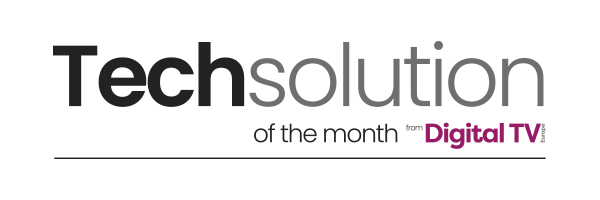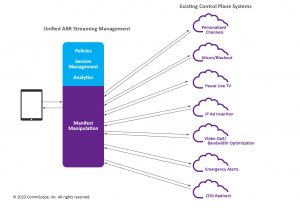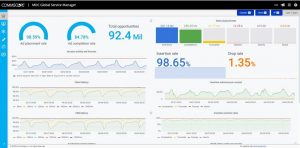
After more than 40 years of operation, DTVE is closing its doors and our website will no longer be updated daily. Thank you for all of your support.
Tech Solution of the Month – Manifest manipulation: unlocking the potential of streaming session management

Manifest manipulation is well-known to video industry professionals as an enabler of server-side ad insertion. But as CommScope’s Jim Owens testifies, its potentially transformative uses go far beyond advertising.
Adaptive Bitrate (ABR) changed the video landscape by delivering video across multiple devices over standard Internet technologies. But streaming has unique challenges. For one, it’s designed to react to the actions of millions of individual video players. As such, the technologies to manage streaming video are inherently reactive. Manifest manipulation, combined with sophisticated management tools, can provide a more proactive, network-centric model for personalising and managing the overall quality of the video experience.
Manifest manipulation is a term familiar to many industry professionals as a key technological foundation of server-side ad insertion.
The use of manifest manipulation is something of a hot topic. Advertising-based business models for streaming video are currently experiencing an upsurge of interest. The launch of FAST (Free Ad-Supported Streaming TV) channels, and growing interest in AVOD (Advertising Supported Video On Demand) to supplement a slowly flattening curve of subscription video adoption mean that advertising – and specifically targeted advertising – is seen as a revenue source with high growth potential.
As interest in addressable advertising grows, demand for solutions in this area is also growing.
Service providers looking to monetise content through addressable advertising in an IP video environment need to ensure that revenue is maximised by targeting ads effectively and delivering them reliably.
In addition, the experience of transitioning between content and adverts must appear to be seamless to the viewer on any device.
When done correctly, manifest manipulation helps enable this. Adaptive bitrate streaming video creates segments or chunks of video, and the manifest provides the client with instructions for downloading and playing those media segments. Manifest manipulation is essentially a server-side process of editing the manifest. This can be used to insert a new advert into a stream, replace existing ads, or expand an ad break to incorporate new ads, all based on information about the device, viewer and/or the content. The manifest manipulator can adjust the manifest appropriately for each device and match the format of the new adverts to be inserted into the content. This includes inserting ad content at the appropriate bitrate, in the appropriate codec for the end device in any given situation. For example inserting 4K adverts in 4K streams and lower bitrate adverts in lower bitrate streams targeted to phones. In an advanced solution, the manifest is adjusted using pre-set rules to enable workflow automation. Delivering the appropriate manifest to each device makes it possible to provide a targeted ad to each client user device.
Beyond advertising
Manifest manipulation is a key technology for enabling seamless targeted ad insertion in an adaptive bitrate IP video environment. However, since the manifest controls everything presented to the client, CommScope, Inc. of North Carolina, a leading technology provider, believes that manifest manipulation has applications that extend far beyond advertising.
As one example the technology could be used to balance the trade-off between video quality and delivery costs.
When initiating an adaptive bitrate stream, the client typically requests a low bitrate segment to start the session, then shifts to higher bitrates based on how quickly the video is delivered.
Manifest manipulation can be used to customise which bitrate options are presented to the client. For viewers watching TV on a mobile device, the service provider may want to remove the top bitrate to reduce delivery costs while not affecting the viewing experience. For viewers on 4K connected TVs on a reliable connection, the lower bitrates may be removed to eliminate a poor-quality experience at the start of a session.
There is a plethora of other potential applications for manifest manipulation beyond its current use to direct appropriate advertising to clients. These include content replacement, emergency alerts, pause live TV functionality and bandwidth optimisation.
“Manifest manipulation is a very powerful tool,” says Jim Owens, Senior Director of Product Management for Video Advertising Technology at CommScope. “And if you build a platform around it that can integrate with other third-party sources of information to manage video sessions from start to finish, it becomes even more powerful.”
Owens says that manifest manipulation could be used to handle complex scenarios such as directing a stream to an underused CDN, responding to a client requesting to pause live TV, and enabling a targeted advert to be inserted in the stream once it resumes. Meanwhile, if network traffic is dangerously congested, manifest manipulation could automatically remove the higher bitrates within an adaptive bitrate stream, and subsequently manage the insertion of an emergency alert when an approaching tornado threatens the viewer’s area.
What’s needed to pull off this scenario is a management solution that enhances the manifest manipulator with flexible policies, an engine to run them, and monitoring tools to report on the video sessions.
Unlocking potential
Until now, mainly larger OTT and video service providers have experimented with these kinds of applications. CommScope proposes to make the tools to unlock the potential of manifest manipulation much more widely.
The company’s existing Manifest Delivery Controller (MDC) product is the key technology to enable what Owens believes will become an all-important category of functionality – streaming session management.
While manifest manipulation is a relatively well-established technology – CommScope’s own involvement dates back to its 2014 acquisition of Emmy®-award winning SeaWell Networks – it has not been widely used to solve the full range of challenges that service providers face.
Owens strongly believes that such a manifest manipulation solution, by providing a single underlying platform to support multiple services, will enable service providers to deliver advanced streaming services and improved quality more efficiently and effectively than would be the case if they deployed multiple discrete systems.
“Today, the business case around manifest manipulation is built on advertising. However, if you are going to select a solution for server-side ad insertion, it makes sense to invest in a platform that will enable you to add other services later. If you don’t think about all the applications you want to enable, you may end up deploying another solution later and the two won’t be able to coordinate across a video session,” he says.
CommScope has built a platform with technology that can track and manage every session precisely. This has an obvious application in advertising insertion, enabling service providers to measure the success rate of client requests for ads, interactions with ad decision servers, and errors from other parts of the ecosystem, such as the CDN.
However, because the platform can implement rules and workflows on an individual per-device basis, its ability to track and monitor each session has a much wider application. If, for example, it finds that a CDN is not functioning, the session could be steered to a different CDN or edge cache in-stream without the need to drop and start a new session. The use of the technology in this way is timely. Demand from service providers for applications such as bandwidth optimisation are likely to grow in importance as service providers deliver an ever-greater proportion of video consumed via ABR streams rather than broadcast or IP multicast.
Business rules
This is not to say that manifest manipulation can solve all problems with a one-size-fits-all template. Each service provider will inevitably have developed a unique ecosystem, requiring some specific integration. However, says Owens, because CommScope’s technology is built around the implementation of business rules and workflows that can accommodate multiple variations under the hood, it can be applied in a variety of environments with relatively little tailoring to meet specific network requirements.
“MDC can create rules unique to a particular customer and that enables the system to be very flexible. We don’t have to re-write the software for every customer,” he says. “If, say, a packager implements break attributes in a particular way, we can accommodate that by creating a rule for that video source and adapting to it.”
CommScope’s vision of streaming session management based on the effective use of manifest manipulation will, he says, make it easier for service providers to use multiple IP video vendors by creating a common front end for multiple devices.
CommScope believes its technology can be applied to meet a wide range of IP video requirements,. The manifest manipulator has adapters that address different service categories, such as ad insertion and alternate content/blackout insertion– where it could, for example, create a manifest that delivers a 30-minute buffer to accommodate pause and also provide for dynamic ad insertion within the paused video stream.
CommScope is also looking to target a broad range of service providers spanning both traditional fixed-line operators and new OTT streaming service providers.
Today, streaming session management, which so far has only been applied very selectively beyond the core function of advertising insertion with a few leading service providers, is typically deployed on premise. Owens believes that , there is also a need for a cloud-based solution. For the core fixed-line providers, he believes, there will also be a need for hybrid cloud-on-premises solutions to handle situations when there are significant bursts of traffic over and above the norm.
Owens says CommScope will enhance the functionality of streaming session management around the changing needs of the service provider. Currently, service providers can opt into different licences covering different services such as of server-side ad insertion, personal channels, alternate content, and emergency alerts. In the future, the menu of licences available will extend outwards to other applications such as CDN steering and bandwidth management.
“Our customers don’t have to pay for everything up front. They can add features as they go. While some customers may want to license everything, others may prefer to deploy incrementally,” says Owens.
“In reality most customers today are looking for a solution for advertising,” says Owens, “but in choosing a platform it’s important to think about what your future needs might be.”
Solution focus: What is the MDC?
The CommScope Manifest Delivery Controller (MDC) is a platform for the personalisation and optimisation of Adaptive Bitrate video using manifest manipulation. MDC provides Streaming Session Management for IP video services, enabling content monetisation, improved user experience and reduced costs.
Using sophisticated workflows to enforce configurable rules and policies, MDC can manage and report on millions of simultaneous streaming video sessions while implementing advanced services including:
- Server-Side Ad Insertion (SSAI)
- Personalised Channels
- Alternate Content/Blackout
- Emergency Alert Services
- Bandwidth optimisation
MDC provides the following benefits to video service providers:
- Maximise revenue from IP Video Services through targeted advertising, personalised user experiences and advanced analytics to better understand user behavior
- Serve millions of users with a field-proven, massively scalable solution
- Accelerate time to market for new IP Video Services
- Reduce costs through ease of integration with the existing ecosystem and bandwidth optimisation
MDC is used by some of the world’s leading video service providers, content owners and video technology platforms, who together serve more than 30 million subscribers.
This is sponsored content


